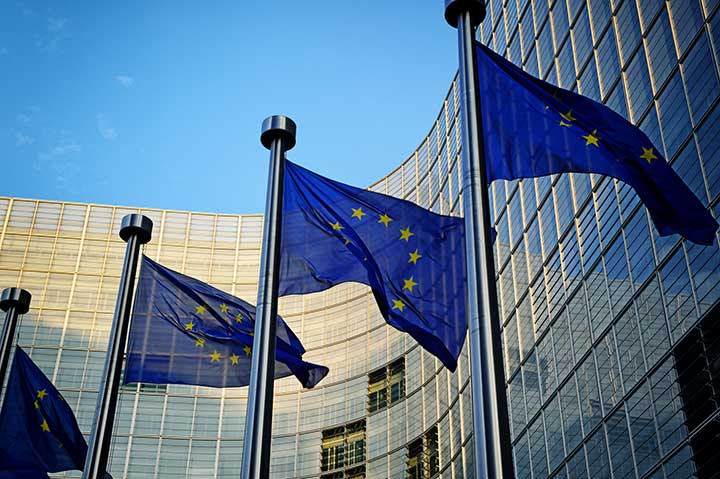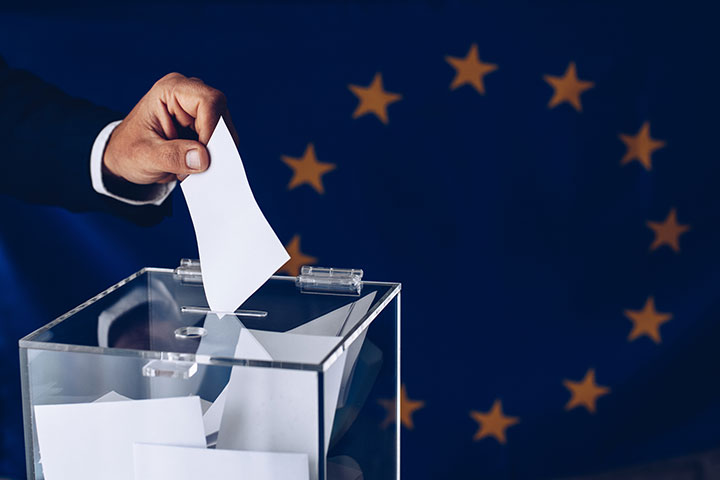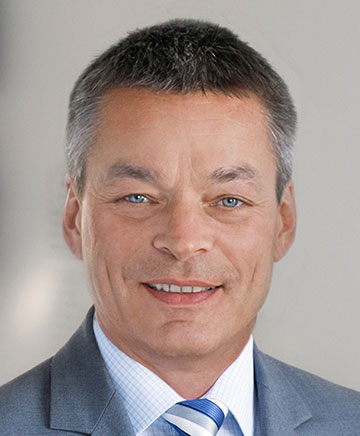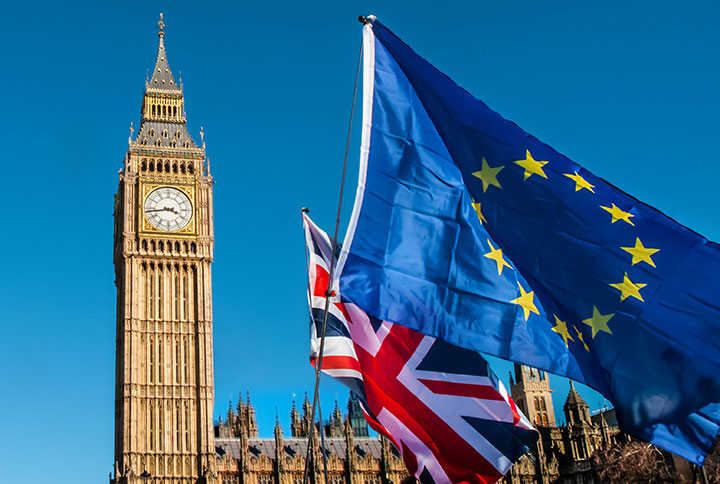
[Image: Getty Images]
When the dust had settled on the European Parliament elections of late May 2019, many science-watchers expressed a sense of relief. In the jittery preceding months, dark voices had predicted that anti-European, nationalist—and, in some cases, arguably anti-science—parties might sweep into power in the parliament, adding weight to the centrifugal forces threatening the European Union. But while such parties did indeed gain ground, the much-heralded wave of populist and Euroskeptic parliamentary victories failed to materialize.
Nonetheless, if the election results left the EU with the feeling of having dodged a bullet, they also highlighted political realignments that suggest that the months and years ahead will be far from business as usual. The potential impacts of the U.K.’s exit from the union still shadow the near-term outlook. The optics and photonics community, especially through the vehicle of Photonics21, continues its effort to cajole the European Commission into raising photonics’ profile in the EU’s next big funding framework, Horizon Europe. And it’s all happening at an unusually uncertain, fluid moment for international trade and business generally.
Deconstructing the election

[Image: Getty Images]
One big story in the European parliamentary election lay simply in voter turnout. Some 214 million Europeans cast votes in the election between 23 and 26 May. And while that constituted only 51% of the electorate, it still represented the highest turnout in more than 20 years—a clear sign of renewed interest in Europe’s future direction.
In the poll itself, three right-wing, Euroskeptic groups in the parliament increased their number of seats from 118 to 176, and the four big pro-EU groups saw their number of seats decline from 529 to 513. But that still leaves EU-friendly forces with a sizable majority. More interesting, perhaps, have been the realignments within that broadly pro-Europe bloc—in particular the substantial gains of two more liberal members, the Alliance of Liberals and Democrats (rebranded as Renew Europe) and the Greens, which together saw their total share rise from 117 seats to 181.
R&D spending: Tail, not dog

Roberta Ramponi. [Image: Courtesy of R. Ramponi]
Roberta Ramponi, the director of CNR-IFN (the Institute for Photonics and Nanotechnologies) and a professor of physics at Politecnico di Milano, Italy, as well as an executive board member of Photonics21, notes that, given growing concerns about climate change and other societal issues, the rise of these parties at the European Parliament level is not too surprising.
“Typically, especially young people, when they vote in the European elections, they try to look at the far future, and large problems become more important,” she says. “Whereas, in the national elections, people are focused on personal problems—what are [politicians] going to do for employment; do they promise less tax or more tax; these kinds of things.”
Some have suggested that the rise of the liberal and Green parties might bring some small shifts in science and technology spending priorities—for example, a move toward greener policies. But that prospect seems much more likely to shape programs such as the EU’s massive Common Agricultural Policy than those closely tied to photonics. “You should never forget,” says Martin Schell, an executive director of the Fraunhofer Heinrich Hertz Institute (HHI), that the European Commission “is by far dominated by farming, in terms of money spent, and then by infrastructure. The common R&D is the tail of the dog—definitely not the dog.”
Shrinking center
Whatever their underlying reasons, the liberal and Green gains came at the expense of the two centrist blocs—the center-right European People’s Party and the center-left Socialists and Democrats—that have long served as the European Parliament’s unofficial governing coalition. For the first time in the body’s history, these two parties have fallen to a minority of the seats in the parliament, shrinking from 55% of seats in the last election to 44% in this one.
Some voices have expressed concern that the collapse of this “democratic middle,” and the greater fragmentation in the new parliament, could make it harder to push through big-ticket legislation and initiatives. That fear is certainly relevant to the next big EU funding framework program, Horizon Europe, which will cover EU-level research and innovation spending for the seven years beginning in 2021.
Only a day before the last parliament dissolved, on 17 April, it approved an agreement on the broad outlines of Horizon Europe, which currently has a “provisional budget” (excluding defense-related research) on the order of €94.1 billion over the seven years. But while the last parliament put the general framework into law, nuts-and-bolts details such as the actual budget, its apportionment, and the treatment of non-EU member countries in the funding scheme will fall to the new, more politically diverse and likely more fractious parliament. And that could bring unpredictable results.

Martin Schell. [Image: Courtesy of M. Schell]
On the question of research participation by countries outside of the union, at least, Schell sees reason for optimism based on the EU’s track record. “The European community has a strong history, in their research framework programs, in collaborating with non-European [Union] countries, for example, Switzerland and Israel,” he says, adding the caveat that these parties are required to “bring their own money.” But, he says, “if a non-European government sees some value in that, I believe that from the EC side there would be no obstacle.”
The picture for photonics—and the Photonics PPP
For photonics, of course, uncertainties related to Horizon Europe surfaced months before the May elections. Under the previous framework, Horizon 2020, covering EU research funding between 2014 and 2020, photonics enjoyed a privileged status as one of six so-called key enabling technologies (KETs). That status came about largely through the efforts of the European technology platform (and industry–academia alliance) Photonics21.
The effort culminated in the formation, in 2013, of the Photonics PPP, a public–private partnership between European Commission and Photonics21. Over the course of the Horizon 2020 period, the PPP has proved very successful, enabling the matching of some €700 million in EC investments in photonics with 4.3 times as many euros from industry, according to a strategic roadmap released earlier this year.
But as the outlines of the upcoming Horizon Europe program emerged from the bureaucratic mist late last year, it became clear that the new framework program would take a somewhat different tack. That realization spawned an intense industry lobbying effort, including a much-publicized open letter from three photonics Nobel laureates. And the future status of the Photonics PPP remains, according to Roberta Ramponi, the subject of active negotiation with the EC.
Member state voices
Ramponi ties a number of the strategic changes in Horizon Europe to some of the same regional political forces manifest in the recent parliamentary election.
“We would have liked to go on with business as usual, building on the success in Horizon 2020 to become more and more competitive in the worldwide scenario,” she says—ideally with a doubling of the funding contribution from the EC. “Negotiation is open,” Ramponi continues, “but in the end the EC budget actually comes from the member states—and the member states seem to be pushing for more control on how the budget is actually spent by the commission.”
As a result of that changing sentiment, Ramponi says, Horizon Europe might rely less on vehicles such as public–private partnerships (and another, related structure, so-called joint undertakings), and leave a larger share of the funding under general targets. That would leave the member states with the possibility of adjusting strategies during the seven years of the framework program. Funding resources would still be available for photonics, Ramponi admits, through competition for those individual programs dispersed throughout the Horizon Europe framework.
“But of course,” she argues, “if you think as a community, and you want to keep developing technologies, you would like to know from the beginning how to develop your budget.” And—especially for an industry like European photonics, which consists largely of a constellation of small and medium-sized enterprises (SMEs)—that’s much more easily done through the vehicle of a PPP, according to Ramponi.
Making the cut

[Image: Getty Images]
Over the course of 2019, the photonics industry has been actively trying to make that case to the European Commission. And Ramponi believes that the effort may be gaining traction. “I am more optimistic than I would have been two months ago,” she says.
The situation on the ground right now is that photonics will be one of a group of PPPs—most likely around 44—that the commission will propose to the member states for the next framework program. “They will probably cut some of those 44, reasonably around 10%,” says Ramponi. And the photonics community is busily lobbying the individual member states to make that cut. (In a recent position paper, Photonics21 argued not only for continuing the PPP, but for a doubling of the EC contribution for photonics in Horizon Europe under its aegis, to €1.4 billion over the seven years of the program.)
Ramponi herself believes that the re-emergence of national politics in EU research governance could ultimately prove counterproductive. “One of the good aspects of having a European Union,” she points out, “is somehow to share the goals and to have the maximum possible synergy.” And while many argue that the continent’s largest economies, Germany and France, swing too heavy a hammer in Brussels, she notes that at least the centralized EU structures require a negotiation among all of the 28 member states. By contrast, she says, “if you get to a point where every country just tries to set its own priorities—well, the largest and the most powerful will still win, in a more straightforward way.”
Brexit’s uncertain impact

[Image: Getty Images]
One area where national politics have clearly upended EU norms, of course, is the ongoing Brexit saga. At present, with the U.K. embroiled in its own leadership contest in the wake of Teresa May’s resignation as prime minister, the odds of a hard, “no-deal” Brexit appear to have substantially increased.
But Ramponi believes that some mechanism will need to be found to keep Britain in the EU game for photonics research. “We really don’t see how we can do without the U.K.,” she says—noting that in terms of EU market share, Britain ranks among the first four countries, with Germany clearly in the lead and France, The Netherlands and the U.K. following.
For his part, Martin Schell of Fraunhofer HHI believes that, notwithstanding occasional talk of a second referendum or some other walk-back, there is “no other possibility” than that, deal or no deal, the U.K. will leave the EU. But he doesn’t think that the consequences of the split are necessarily “of as large a significance as it’s often presented in the media.”
In Europe, he maintains, “we are used to collaborating with institutions in a number of countries,” whether they’re EU members or not. And, while there will likely be “a big hiccup in the transition period,” he notes that it’s in both the U.K.’s and the EU’s interests to find a way to continue to work together. “Maybe I’m naïve,” says Schell, “but I’m quite optimistic that everyone wants it to be as smooth as possible.”
Headwinds from abroad?
In a larger sense, especially in specific sectors of photonics, broader world trade and macroeconomic issues could ultimately carry more weight than EU politics. Schell—whose institution recently hosted a World Technology Mapping Forum meeting on integrated photonics—says that in that discipline in particular, “the potential of China and the United States not being allowed to talk to each other is probably more important than Brexit or growing skepticism of the European community.”

Tom Hausken. [Image: Courtesy of T. Hausken]
Tom Hausken, OSA’s senior industry advisor, echoes that sentiment. “The Photonics21 and Horizon Europe funding is important,” he says, “but the European photonics business is not going to live and die on that. Now, if there are tariffs between the U.S. and Europe, or if the issues with Huawei start to ripple through Europe, that could be much more consequential … Huawei is all over Europe.”
The continent received another reminder of the potential importance of such international linkages—and threats—just days ago, after the outgoing head of the European Central Bank, Mario Draghi, noted that the bank might ease monetary policy to address economic sluggishness in the Eurozone. His comments received an immediate rebuke, via Twitter, from the president of the United States. President Trump tweeted that the ECB was attempting to give Europe an unfair competitive edge, and that Europe had “been getting away with this for years, along with China and others.”
Photonics in the middle
Notwithstanding these tensions, Hausken sees some common political threads between Europe and the United States. “It’s not so much right versus left, as it is outsiders versus mainstream,” he notes. “It’s the middle, this time, that’s left out.”
And the photonics business, he believes, lies squarely in that middle. “I have never met a European photonics person who didn’t express belief in the EU,” Hausken says, noting the role the union has played not just in funding, but in freedom of movement for students, postdocs and other workers, in collaborative structures and in other opportunities.
“The way I see it, the photonics community has everything to gain from the EU, and nothing to lose,” says Hausken. “There might be grumbling about how things are run, but our community is one that takes EU existence as a given.”
